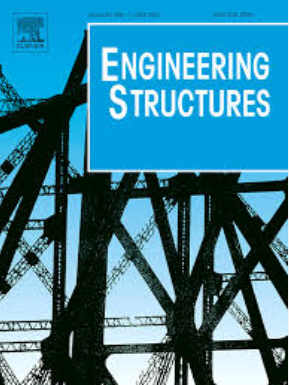Experimental and theoretical investigation of short-term behavior of unbonded prestressed bamboo scrimber-steel composite beams
IF 5.6
1区 工程技术
Q1 ENGINEERING, CIVIL
引用次数: 0
Abstract
This paper investigates a novel unbonded prestressed bamboo scrimber-steel composite beam by embedding steel tubes within bamboo scrimber to form channels, through which steel bars are threaded and prestressed after shaping. Four-point bending tests were conducted to evaluate the effects of reinforcement ratio and prestress level on the short-term flexural behavior of the beam. The failure modes, load-midspan deflection, ultimate bearing capacity, stiffness, and strain distribution of the beams were analyzed based on the experimental data. The test result showed bamboo scrimber beams strengthened with steel with a reinforcement ratio ranging from 1.84 % to 5.23 % experienced a significant increase in ultimate bearing capacity of 5.64∼29.09 % and an increase in flexural stiffness of 5.71∼24.31 %. Flexural stiffness increases with the reinforcement ratio. Enhancing both the reinforcement ratio and prestress level effectively improves ultimate bearing capacity. However, as the reinforcement ratio increases, the impact of increasing the prestress level on improving ultimate bearing capacity diminished. Based on the deformation model of unbonded prestress bars, a theoretical model for the ultimate bearing capacity of the unbonded prestressed bamboo scrimber-steel composite beams was established. The calculated value of the bearing capacity was in good agreement with the test results.
求助全文
约1分钟内获得全文
求助全文
来源期刊

Engineering Structures
工程技术-工程:土木
CiteScore
10.20
自引率
14.50%
发文量
1385
审稿时长
67 days
期刊介绍:
Engineering Structures provides a forum for a broad blend of scientific and technical papers to reflect the evolving needs of the structural engineering and structural mechanics communities. Particularly welcome are contributions dealing with applications of structural engineering and mechanics principles in all areas of technology. The journal aspires to a broad and integrated coverage of the effects of dynamic loadings and of the modelling techniques whereby the structural response to these loadings may be computed.
The scope of Engineering Structures encompasses, but is not restricted to, the following areas: infrastructure engineering; earthquake engineering; structure-fluid-soil interaction; wind engineering; fire engineering; blast engineering; structural reliability/stability; life assessment/integrity; structural health monitoring; multi-hazard engineering; structural dynamics; optimization; expert systems; experimental modelling; performance-based design; multiscale analysis; value engineering.
Topics of interest include: tall buildings; innovative structures; environmentally responsive structures; bridges; stadiums; commercial and public buildings; transmission towers; television and telecommunication masts; foldable structures; cooling towers; plates and shells; suspension structures; protective structures; smart structures; nuclear reactors; dams; pressure vessels; pipelines; tunnels.
Engineering Structures also publishes review articles, short communications and discussions, book reviews, and a diary on international events related to any aspect of structural engineering.
 求助内容:
求助内容: 应助结果提醒方式:
应助结果提醒方式:


